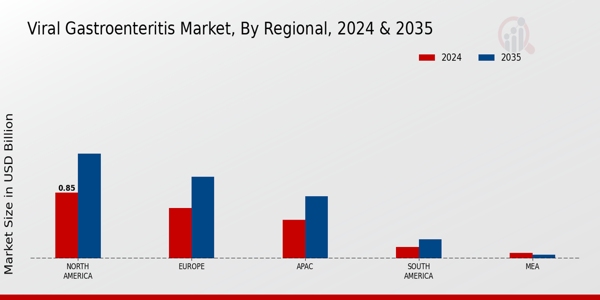Market Trends and Projections
Growing Demand for Vaccination
The growing demand for vaccination against viral gastroenteritis is a significant driver for the Global Viral Gastroenteritis Market Industry. Vaccines, particularly for rotavirus, have demonstrated effectiveness in reducing the incidence of severe gastroenteritis in children. As awareness of the benefits of vaccination increases, more countries are incorporating these vaccines into their immunization programs. This trend is likely to bolster market growth, as evidenced by the projected market value of 2.22 USD Billion in 2024. The potential for widespread vaccination campaigns could lead to a substantial decrease in hospitalizations and healthcare costs associated with viral gastroenteritis.
Advancements in Diagnostic Technologies
Technological advancements in diagnostic methods are significantly influencing the Global Viral Gastroenteritis Market Industry. Rapid and accurate diagnostic tests, such as polymerase chain reaction (PCR) and enzyme immunoassays, enable healthcare providers to identify viral pathogens swiftly. This efficiency not only improves patient outcomes but also enhances outbreak management. As healthcare systems increasingly adopt these technologies, the market is expected to expand, with a projected growth rate of 4.23% CAGR from 2025 to 2035. The integration of these advanced diagnostics into routine clinical practice is crucial for controlling the spread of viral gastroenteritis.
Increased Focus on Hygiene and Sanitation
The global emphasis on hygiene and sanitation practices has a profound impact on the Global Viral Gastroenteritis Market Industry. Governments and health organizations are actively promoting hand hygiene, safe food handling, and sanitation measures to mitigate the transmission of viral gastroenteritis. Public health campaigns and educational initiatives are being implemented worldwide, particularly in developing regions where the burden of disease is high. This proactive approach is expected to contribute to market growth, with the industry projected to reach 3.5 USD Billion by 2035. Enhanced hygiene practices are essential for reducing the incidence of viral infections.
Rising Incidence of Viral Gastroenteritis
The increasing incidence of viral gastroenteritis globally is a primary driver for the Global Viral Gastroenteritis Market Industry. Factors such as poor sanitation, contaminated water sources, and inadequate hygiene practices contribute to the spread of viruses like norovirus and rotavirus. In 2024, the market is projected to reach 2.22 USD Billion, reflecting heightened awareness and demand for preventive measures. Countries with limited access to clean water are particularly affected, leading to a surge in healthcare costs and the need for effective treatment options. This trend is likely to continue, emphasizing the importance of addressing viral gastroenteritis on a global scale.
Emerging Markets and Healthcare Infrastructure Development
Emerging markets are playing a crucial role in shaping the Global Viral Gastroenteritis Market Industry. As countries in Asia, Africa, and Latin America develop their healthcare infrastructure, there is a growing need for effective treatments and preventive measures against viral gastroenteritis. Investments in healthcare facilities, improved sanitation, and public health initiatives are expected to drive market growth. The projected CAGR of 4.23% from 2025 to 2035 indicates a robust expansion in these regions. As healthcare access improves, the demand for antiviral medications and diagnostic tools will likely increase, further propelling the market.













